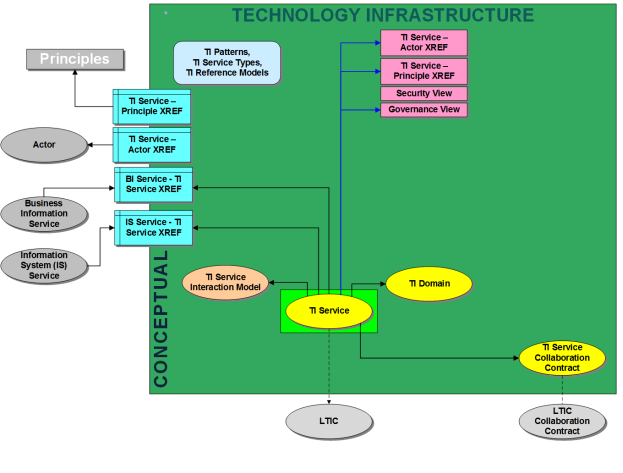|
Service
|
Describes for Technical Infrastructure Services the runtime environments (.NET, JEE or z/OS-LE).
<.NET/ JEE/ z/OS-LE/ Connectivity/ Security/ Business Service Management.>
|
|
Title
|
A suitable (and preferably unique) short form name for the artifact.
|
|
KPIs
|
Identify the KPIs for the service. This will be a subset of the attributes that is measured for
performance, e.g.:98,5% delivered within defined business response times; Max 5%of errors as a result
of the business service; Able to handle volumes within a bandwidth of 25% of the defined mean volumes.
|
|
Trigger/Actor
|
The event or initiator that causes this service to be started/consumed.
|
|
Confidentiality Classification
|
Classify and explain the level of Information Confidentiality to be supported by this service.
Confidentiality Classification is based on the risk, specifically the impact, of unauthorised
disclosure or intelligible interception. Confidentiality Classification is thus the protection level
needed of sensitive information from unauthorised disclosure or intelligible interception. The
classification should follow the organization security or risk management guidelines; or define and use
a High/Medium/Low categorization if one is not available.
|
|
Integrity Classification
|
Classify and explain the level of Information Integrity to be supported by this service. Integrity
Classification is based on the risk, specifically the impact, of not having accurate or complete
information. Integrity regards safeguarding the accuracy and completeness of information (and thus
processes, IT systems and computer software). The classification should follow the organization
security or risk management guidelines; or define and use a High/Medium/Low categorization if one is
not available.
|
|
Availability Classification
|
Classify and explain the level of Information Availability to be supported by this service.
Availability Classification is based on the risk, specifically the impact, of not having information
available (accessible or available in time). Availability Classification regards guaranteeing that
information and vital services are accessible (accessibility) to authorised users when required
(timeliness) The classification should follow the organization security or risk management guidelines;
or define and use a High/Medium/Low categorization if one is not available.
|
|
Uniqueness Classification
|
Classify and explain the level of Information Uniqueness to be supported by this service. Uniqueness
Classification is based on the risk, specifically the impact, of not having unique or unambiguous
information about a specific subject. The classification should follow the organization risk management
guidelines; or define and use a High/Medium/Low categorization if one is not available.
|
|
Consistency Classification
|
Classify and explain the level of Information Consistency to be supported by this service. Consistency
Classification is based on the risk, specifically the impact, of not having consistent information
(consistent within itself or with other information across the organization). The classification should
follow the organization risk management guidelines; or define and use a High/Medium/Low categorization
if one is not available.
|
|
Compliance Classification
|
Classify and explain the level of Information Compliance to be supported by this service. Compliance
Classification is based on the risk, specifically the impact, of not complying to relevant legislation,
policies or standards. The classification should follow the organization risk management guidelines; or
define and use a High/Medium/Low categorization if one is not available.
|
|
Service window
|
Or opening hours, describes when the service should be available.
|
|
Response time
|
Describes the normal/average and maximum time to fully process a service request. Optionally because
for most TI services, cannot be specified on this level. Depends largely on the application using the
service.
|
|
Throughput
|
Describes the average throughput per application (number of requests per period over time) the service
can handle.
|
|
Throughput period
|
Describes the throughput period. <Second/ Minute/ Hour/ Day/ Week>
|
|
Scalability
|
Describes the maximum throughput per application (number of requests per period over time) the service
can handle.
|
|
Scalability period
|
Describes the scalability period. <Second/ Minute/ Hour/ Day/ Week>
|
|
MTTR
|
Describes the mean time to repair of the service in case of incidents. (MTTR is behavioural aspect and
is specifically linked to the service.)
|
|
MTBF
|
Describes the mean time between failures of the services (MTBF is behavioural aspect and is
specifically linked to the component)
|
|
Communication mechanism
|
Describe the API with which the service can be invoked.
|
|
Quality of information required
|
Describe the required quality of the information required to be supported by the service. This is to
ensure information is fit for purpose for use in the business (logical Information Aritfacts may give
guidance for this) This should be expressed as an Information Quality KPI target, e.g. 98% of customer
information must be complete. It important to have the target level to avoid gold plating any design.
This can be done on the Information Object or Logical Information Component level, or both. The
following dimensions can be considered:Confidentiality
-
Completeness
-
Accuracy
-
Validity
-
Accessibility
-
Timeliness
-
Uniqueness
-
Consistency
-
Compliance
|
|
Quality of information delivered
|
Describe the required quality of the information required to be supported by the service. This is to
ensure information is fit for purpose for use in the business (logical Information Aritfacts may give
guidance for this) Details as above.
|
|
Result
|
Describes the result of correct usage of the service.
|
|
Error handling
|
Describes the result of incorrect usage of the service.
|
|
Input Object(s)
|
The object(s) consumed or used by this service
|
|
Output Object(s)
|
The object(s) created or transformed by this service or component
|
|
Input Control(s)
|
A description of the control info required as input. (This is an optional attribute.)
|
|
Output Control(s)
|
A description of the control info provided as output. (This is an optional attribute.)
|

